Electromagnetism in finite element method
23. September, 2009, Autor článku: Belák Rastislav, Elektrotechnika, Študentské práce
Ročník 2, číslo 9  Pridať príspevok
Pridať príspevok
 This work is focused on solving multiphysicals fields with Finite Elements Method (FEM). Headline of this work are two electro magnetic analyses. First analysis offers confrontation between analytic calculation of electro magnetic forces of electro magnetic actuator and analysis using ANSYS® program using FEM. This part of work presets well uses FEM for solving electro magnetic problems. Second analysis shown electro magnetic forces progress in trigger of circuit breaker. This analysis is more complex because it uses more realistic material properties and boundary conditions. This analysis can be helpful to create other electro magnetic analyses for solving complicated electro magnetic problems in electro magnetic devices.
This work is focused on solving multiphysicals fields with Finite Elements Method (FEM). Headline of this work are two electro magnetic analyses. First analysis offers confrontation between analytic calculation of electro magnetic forces of electro magnetic actuator and analysis using ANSYS® program using FEM. This part of work presets well uses FEM for solving electro magnetic problems. Second analysis shown electro magnetic forces progress in trigger of circuit breaker. This analysis is more complex because it uses more realistic material properties and boundary conditions. This analysis can be helpful to create other electro magnetic analyses for solving complicated electro magnetic problems in electro magnetic devices.
Introduction
Finite Element Method in co-operation with appropriate program offers powerful instrument to examine physical fields. Electro magnetic field is peculiar part of physical fields characterized by non-homogeneously and non-linearity come out from ferromagnetic material properties.
In mostly tasks analytic solution is not possible. For application example FEM to electromagnetic field has been pick out simple electromagnetic actuator. Electromagnetic force has been calculated by analytic method and Finite Elements Method. Results both methods have been mutual compared. Second analysis is focus on concrete task of circuit breaker with non-linear material properties.
Analytic method of electromagnetic actuator
Model of electromagnetic actuator is on picture (Fig.1). For actuator electromagnetic force calculation is needed to know value of flux density (1) in dot A (Fig.1) on edge of two environments air and iron. Graph of electromagnetic force of actuator (2) will have similar shape like unpaired power function because air gap δ (1) is variable.
This analytic calculation is correct only for constant permeability value of iron parts but the constant permeability is acceptable for mean current values in excitation coil. This model suits to assumptions. Permeability represents linear dependency flux density on flux intensity (3).
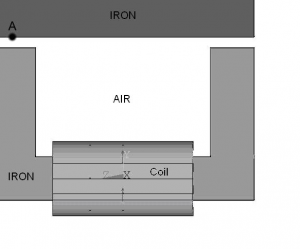
Fig. 1 Model of electromagnetic actuator
Higher excitation current needs to compute with hysteresis in feromagnetic parts.
| (1) |
| (2) |
| (3) |
where
N − number of turns
I − Total excitating current
l − Total length of magnetic circuit
δ − Length of air gap
− vaccum permeability
− relative permeability
A – cross section area of magnetic circuit
Analytic method of electromagnetic actuator
Actuator on picture (Fig. 1) was also applied on electromagnetic FEM analysis. Finite element method is based on creating continuum of small regions connected through nodes. Known values of physical quantity are applied on the edges of the model. Other unknown physical quantity will be calculating through iteration process in all the rest nodes. Accuracy FEM depends on created mesh of elements, its number and right material properties.
Model of electromagnetic actuator
Model composed from two parts of ferromagnetic material (iron), excitation coil and surrounding air. Between iron part is situated small air gap. Electromagnetic force causes thinning this gap to zero.
Definiteness conditions
The actuator is exciting by coil with 2000 turns with total current 1A. Magnetic flow causes by coil is mostly closed through irons parts with squared cross sections and air gaps. Air gap is small in range 3e-3 m to near to zero (0,1e-3m). On upper iron part was apply force condition for calculating forces and torques. Calculating process is stepped with thinning air gap to zero.
Comparing of analytic method with finite element method
Graph of electromagnetic force in actuator calculated by analytic method is shown on picture (Fig.2) with graph of FEM analysis. Differences between both methods are higher near larger air gaps. This difference results from higher disperse of magnetic flow in the gaps. This fact is not covered in analytic method which causes other result for magnetic flux density in larger air gaps.
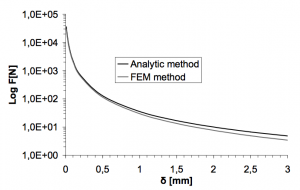
Fig. 2 Results of analytic and FEM calculations
On picture Fig.3 is shown direction of electromagnetic forces in upper iron.
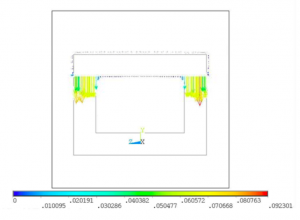
Fig. 3 Vectors of electromagnetic forces in upper iron
Electromagnetic analysis of circuit breaker trigger
Problem shown on picture (Fig. 4) is complicated. In this case is assumed short circuit current in coil 2000 A and therefore hysteresis must be applied as material properties of ferromagnetic materials. Model of circuit breaker trigger is axi-symmetric with symmetry in Y axis. On picture (Fig. 4) is shown model in cutting plane (one half model).
Model of circuit breaker trigger
Model of circuit breaker trigger is composed of movable cylinder iron core A, hollow non-motion iron cylinder B, cylindrical electromagnetic shade C. System is exciting by coil D.
Definiteness conditions
Short circuit current flows through 12 turns in coil. Magnetic flow causes by coil is closed through ferromagnetic cylinders, air gap (3e-3 m) and electromagnetic shade which electromagnetic field concentrate to nearest surrounding of coil and amplify it. On boundary areas of model (air) were apply elements which effects as infinity environment.
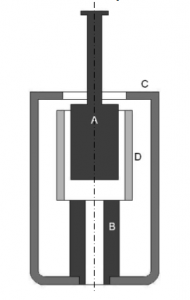
Fig. 4 Model of circuit breaker trigger
Results of electromagnetic analysis of circuit breaker trigger
Electromagnetic analysis shown real material properties have influence to results. BH curve (Fig. 5) presets real dependency magnetic flux density on magnetic flux intensity in ferromagnetic materials. It is a non-linear dependency which means higher requests for calculation process.
Picture (Fig.6) shown graph of dependency electromagnetic force on ferromagnetic core location of circuit breaker trigger. Electromagnetic force is higher on the beginning of motion then slowly falls on the end quickly rises. Ferromagnetic core is very light (0,02 kg) and force (16 N) is able to execute very quick motion to break out electric circuit.
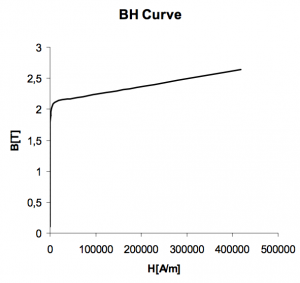
Fig. 5 BH curve used ferromagnetic materials
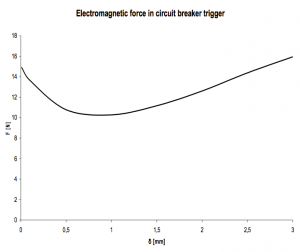
Fig. 6 Graph of electromagnetic forces in circuit breaker trigger
Analyses like this one offers area to investigate new geometric design to find out better properties of circuit breaker for example faster circuits unplugging.
Acknowledgement
This article has been accomplished under VEGA Grant No. 1/4122/07.
References
- Belák, R.,(2008) In:The Multyphysics analysis of defect in magneric circuit of inductive machine, Thesis project, FEI, STU
- ANSYS: Theory manual, FEM program
- Czapffová, E., Dufek, P., Chmel, I., Feranec, P., Riešenie multifyzikálnych polí. Team project, FEI, STU, May 2005
- Murín, J., Metódy konečných prvkov, [online]
http://kmech.elf.stuba.sk/dokumenty/APLIMECH/prednaska_c2.pdf
Co-authors of this paper are G. Gach, T. Paprčka, Slovak University of Technology, Faculty of Electrical Engineering and Information Technology, Ilkovičova 3, 812 19 Bratislava.


12. Október, 2009 o 8:49
Actuators are really needed for complex tasks in the high power market.If the load requires accurate positioning, High power actuators has the advantage among others…